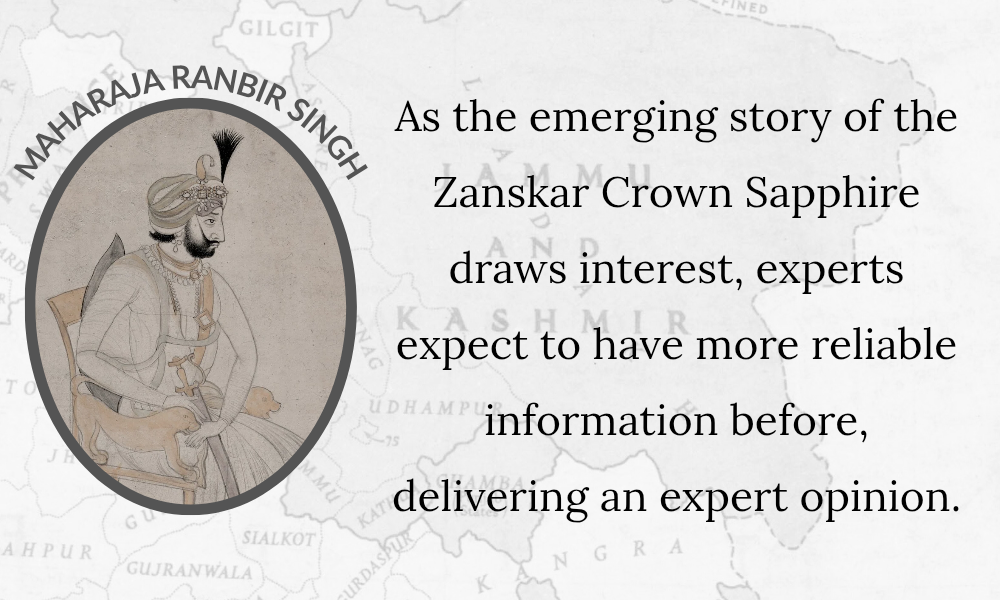zanskar crown Info
Reports trickling in recent times have hinted at a legendary gemstone, a sapphire of majestic proportions and extraordinary provenance, known as the Zanskar Crown Sapphire. While most accounts consistently mention that the sapphire once belonged to the treasury of the Maharajas of Kashmir, the details surrounding this remarkable gemstone remain veiled in mystery. Unclear information about its exact size and current whereabouts has left gem historians, collectors, and enthusiasts debating for decades. Yet, every fragment of the story adds to the aura of the stone — a gem believed to be one of the greatest blue sapphires ever discovered from the celebrated Kashmir mines. Arguably slated to be one of the biggest Kashmir blue sapphires.

THE KASHMIR LEGACY
To understand the fascination surrounding the Zanskar Crown Sapphire, one must first recognize the status that Kashmir blue sapphires hold in the gem world. Mined primarily during a short period between 1880 and 1930, these sapphires are known for their velvety blue color and mesmerizing depth. The rich, cornflower-blue hue combined with a soft, almost ethereal glow distinguishes Kashmir sapphires from all others, including those from Ceylon (Sri Lanka) or Burma (Myanmar).
The discovery of sapphires in the Kashmir region occurred in the early 1880s, during the reign of Maharaja Ranbir Singh, ruler of Jammu and Kashmir. Local shepherds first stumbled upon glittering blue crystals in the Padder Valley region, high up in the Himalayas. This discovery led to the establishment of the famous Kashmir sapphire mines, which, for a brief but glorious period, produced some of the most beautiful blue sapphires the world has ever seen.
ZANSKAR CROWN ORIGIN
It was during this golden period that the rough sapphire, which would eventually become the Zanskar Crown Sapphire, was discovered. Maharaja Ranbir Singh, known for his astute interest in precious gems, acquired the rough stone soon after its extraction. Contemporary accounts suggest that the rough crystal was of exceptional size (probably 500+ carats) and purity, showing an intense blue coloration even in its uncut form.
The rough piece of sapphire was sent to be cut and polished under expert supervision, most likely in British India or possibly in Europe, where gem-cutting expertise was advanced. The result was a magnificent cushion-cut blue sapphire, displaying the signature velvety blue hue that Kashmir sapphires are famed for. As per reports, the big sapphire was cut and polished in Europe.
It was named the Zanskar Crown Sapphire, possibly after the Zanskar Range, a subrange of the Himalayas in the Ladakh region — a name evoking the very mountains that gave birth to the gem. Some deviations in the naming of the glorious Kashmir Sapphire. Some experts claim that, the name given to the cut and polished cushion cut blue sapphire, was Zankar Blue – the name according to them, was given by Maharaja Ranbir Singh.
The other set of opinions is that, it was Maharaja Pratap Singh (successor to Maharaja Ranbir Singh), who named the big Kashmir sapphires – he chose the name, Zanskar Crown. With the current information available, it is best to leave the debate on naming the sapphire for the future.
A GEM OF REGAL SPLENDOR
For years, the Zanskar Crown Sapphire remained in the royal treasury of Kashmir, serving as one of its most prized possessions. Historical sources suggest that the sapphire was occasionally displayed during royal functions and was said to have been mounted on an elaborate ceremonial ornament — a gold necklace, in keeping with royal tradition.
The contradicting rumor that the Zanskar Crown was set in a crown, is more of a distraction than a possibility. This because evidence suggests that crowns, were not popular with Maharajas in the region at that time.
The gem became a symbol of Kashmir’s natural wealth and regal pride. Its sheer size and beauty reportedly surpassed most other sapphires known at the time. Based on the available, though unconfirmed, estimates, the Zanskar Crown Sapphire is believed to have weighed between 170 and 220 carats, an extraordinary figure that, if verified, would make it the largest known Kashmir blue sapphire in existence.
For context, the largest documented Kashmir sapphire today is The Spirit of Kashmir, weighing 150.13 carats. Should the lower end of the Zanskar Crown’s reported size be accurate, it would easily surpass that record, taking its place as the true monarch of Kashmir sapphires.
MAHARAJAS AND THE ZANSKAR CROWN
The story of the Zanskar Crown Sapphire is intertwined with the history of two significant rulers of Jammu and Kashmir — Maharaja Ranbir Singh and Maharaja Pratap Singh.
As mentioned earlier, Maharaja Ranbir Singh was the one who first acquired the rough sapphire and commissioned its cutting. His reign was marked by a deep appreciation for art, culture, and precious objects. The Zanskar Crown was a reflection of the splendor of his court, a gemstone that symbolized both natural beauty and royal majesty.
After his death in 1885, his successor, Maharaja Pratap Singh, inherited the gem along with other royal treasures. However, by the early 20th century, the socio-economic conditions in Kashmir had begun to shift. Pratap Singh, known for his sincere desire to improve the infrastructure and development of Kashmir, faced significant financial pressures.
It is believed that around 1920, in an effort to raise funds for developmental projects, Maharaja Pratap Singh decided to part with some of the royal jewels — including the Zanskar Crown Sapphire. The decision reflected both his pragmatism and his genuine concern for the progress of his people. The funds from the sale were reportedly used to support public works, improve administrative facilities, and modernize certain sectors of Kashmir’s economy.
DISAPPEARANCE AND MODERN INTEREST
Following its sale, the trail of the Zanskar Crown Sapphire grows faint. No authenticated photograph or record of its subsequent ownership has yet surfaced. Some gem historians speculate that it might have been sold to a European royal family or a wealthy collector during the early 20th century — a period when fascination with exotic Eastern gems was at its peak. Others believe that the sapphire could have been recut or remounted, losing its original form and identity in the process.
Professional gem collectors remain intrigued by the possibility that the Zanskar Crown Sapphire still exists, perhaps hidden within a private collection or resting unrecognized in a royal vault somewhere in Europe or the Middle East. Occasional reports of unusually large blue sapphires appearing in auctions have reignited interest in the lost Kashmir gem, but none have been conclusively identified as the Zanskar Crown.
THE RARITY OF KASHMIR SAPPHIRES
The allure of the Zanskar Crown Sapphire is magnified by the near-mythical status of Kashmir sapphires themselves. The mines that once produced them were largely exhausted by the 1930s, and today, mining in that region is either minimal or nonexistent. This means that no new supply of authentic Kashmir sapphires is entering the market, making existing stones immensely valuable.
Even small Kashmir sapphires of just a few carats can command extraordinary prices, while larger stones are considered almost priceless. Given this context, a sapphire in the 170 to 220 carat range, assuming it retains the signature “cornflower blue” and “velvety” texture, would command and exorbitant price.
A LEGEND WAITING TO BE FOUND
The Zanskar Crown Sapphire stands as one of the most intriguing mysteries in the world of gemstones. Its rumored size, illustrious royal provenance, and uncertain fate combine to make it a gem of almost mythical proportions. What sets the story apart is not just the gem’s beauty or rarity, but also the historical context that surrounds it — a tale of royal grandeur, natural wonder, and noble intention (for which it was sold).
Maharaja Ranbir Singh’s decision to preserve and polish the gem reflects a ruler’s pride in his land’s natural treasures, while Maharaja Pratap Singh’s sale of the sapphire highlights his earnest commitment to the welfare of Kashmir’s people.
Until more concrete evidence emerges — a photograph, a historical record, or perhaps even the gem itself — the Zanskar Crown Sapphire will continue to captivate imaginations as a lost legend of the Himalayas, a shimmering symbol of Kashmir’s rich gemological and cultural heritage.
SAW2DAY
Compiling available information on various topics and issues. No politics, no religious bias and no racial slant. We do not claim to own or to have seen the Zanskar Crown Sapphire. We have no commercial interest in this historic gemstone. The content in this report has been compiled, from sources online and does not – intend to be a piece of investment advice.
